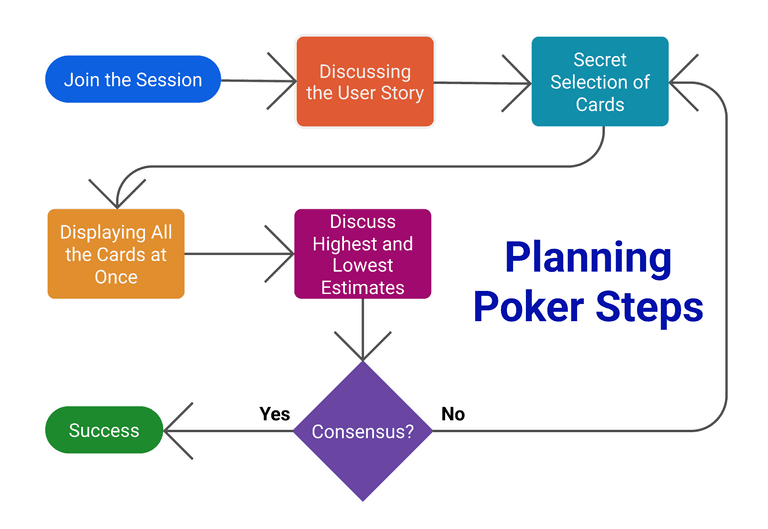How to Execute Planning Poker Rightly with the Correct Order of Steps?
When Planning Poker is conducted rightly, it delivers better estimates, removes cognitive biases, and catches unexpected challenges and scenarios that might show up. Therefore, keep reading this article to learn the right steps to execute Planning Poker.

Agile estimation is the process that helps teams to evaluate the required effort to complete the product backlog items. Software firms using Agile methodology in project development actively estimate their product backlogs to have a clear glimpse of the required efforts before beginning the development cycle. There are multiple estimation techniques that teams can choose from, but Planning Poker stands as one of the most widely used estimation techniques.
The reason behind Planning Poker's popularity is due to its gamified nature and discussion-based estimates that values everyone's opinion and provides accurate estimates. However, the accuracy of Planning Poker estimates highly depends on if all the main steps of the technique are followed rightly. Only then, it can provide the right estimates of the efforts required to complete the product backlog items. Therefore, this article intends to clarify the correct order of steps to execute Planning Poker rightly.
What is Planning Poker?
Planning Poker, also known as Scrum Poker, is a consensus-based, gamified estimation technique that is used to estimate the relative size or effort level of product backlog items. It uses poker-styled numbered cards to assign story points to user stories (product backlog items). These story points provide an estimate of the efforts relative to other user stories.
Planning Poker estimation session involves the Product Owner, Scrum Master, frontend and backend engineers, UI designers, analysts, key stakeholders, and similar others that are linked somehow with the project. However, the estimate is mostly done by development team members that are actually going to work on the project. Those members are provided with numeric cards, based on a modified Fibonacci sequence (0, 1, 2, 3, 5, 8, 13, 20, 40, and 100), to assign story points.
During a Planning Poker estimation session, the development team first listens to and discusses the user stories. Afterward, each member reveals the card to provide individual estimates. Once done, the highest and lowest estimates are discussed and the final team's estimate is reached. By revealing cards instead of speaking them aloud, Planning Poker helps teams avoid cognitive bias, while the mutual discussion helps the team to pinpoint unexpected challenges that they might not notice individually. Overall, Planning Poker is a simple but effective estimation technique that provides an accurate glimpse of the efforts.
Correct Order of Steps to Execute Planning Poker
The accuracy of Planning Poker estimation highly relies on how it is executed. Simple negligence in the steps can take away the true essence of the estimation technique and result in less accurate estimates. For example, if members do not pick cards hiddenly, then the junior members might just pick cards similar to senior members. Therefore, it is very important that Scrum teams follow the correct order of steps in the right way to execute Planning Poker effectively. Below is the correct order of steps to follow during the Planning Poker session:
Step 1. Members Join the Session
The first step in the Planning Poker session is to make everyone come to the meeting room. The Product Owner, Scrum Master, development team, key stakeholders, and similar others are the main parties of the estimation session. However, no one other than the development team should participate in the estimation process. Once all members join the meeting room, each member of the development team should be provided with a set of poker cards.
Step 2. Discussing the User Story
The Product Owner is the one that designs and manages the product backlog items (user stories). So, the product owner takes the first user story and reads it out. After that, the team begins discussing the user story and also clarifies doubts with the Product Owner. During the discussion, the focus is to discuss how to accomplish the targets of user stories and pinpoint possible risks and challenges.
Every member of the development team should be encouraged to participate in the discussion round. It is because some members might be looking at the user story differently and may highlight an expected challenge or issue that others may not see currently. Moreover, members can even reference previous similar stories to see how things went with the execution of those stories. However, discussions should be time-boxed to a few minutes so that the team doesn't spend significant time in just one-story discussion.
Step 3. Secret Selection of Cards and Displaying All at Once
Once the discussion is completed, every member of the development team should pick a card secretly that they think best suits the efforts required to complete that user story. Once everyone has picked the card, they all display it at once.
Step 4. Discuss Highest and Lowest Estimates
Once everyone has revealed the cards, members that have given the highest and lowest estimates are now given a chance to present their views. The ones that have given the highest points might highlight some potential issues. Similarly, the members that have given the lowest points might be thinking of an approach from previous work that could help in completing the task at a fast pace. Therefore, other members first listen to their views and then discuss them together to see how authentic are their ideas. However, all these activities should be time-boxed to avoid extra time spent on them.
Step 5. Re-estimate
Once the discussion is completed, the team goes for the second round of re-estimation. Members again pick a card secretly and then they all present it at once.
Step 6. Consensus or Re-discussion
After the re-estimation, if all members have picked the same card, then that is declared as the team's estimate of that user story. But if again there is some major deviation, then the team again discusses and re-estimates. However, it is recommended to reach a consensus within two rounds of re-estimates, as otherwise, it starts consuming unnecessary extra time. For example, if the team is struggling between story points 8 and 13 for one user story, then it's better to pick the bigger value and declare it as the team's estimate. It is because over-estimation has less adverse impact compared to under-estimation.
After completing the above 6 steps, the team has finally completed the estimation of the first user story. Now the team can follow the same steps to complete the estimation of the remaining user stories. In the end, the team will have assigned story points to all user stories. That's it! So, this is how any team can conduct a Planning Poker session accurately.
How to Extract True Outcomes from Planning Poker Estimation?
Even if the teams follow all the above steps thoroughly, they often don't succeed in achieving accurate estimations. One justification is that they have recently started using the Planning Poker estimation technique, so they might be making mistakes unintentionally. If that's the case, then they can improve the accuracy of their estimates with the passage of time as they get more experienced with Planning Pokers.
Planning Poker is not itself the key player in driving accurate estimates, but its effectiveness relies on the discussion rounds among team members. When all members participate in discussions and share their viewpoints, they might pinpoint some critical aspects of the task that even experts wouldn't have noticed. Opinions are heard and assumptions are checked, thereby leading to more accurate estimates. So, to get fruitful outcomes from a Planning Poker estimation session, the team should emphasize on discussion and make everyone contribute to it, not just the expert/senior members.
Another way to improve outcomes from Planning Poker is to use reference data. For example, a team is discussing a user story that is similar to the one they did in the past. So, they should check how that story went, was the estimate accurate, whether there were any hurdles, etc. This way, they can use that reference data and try to do more accurate estimates this time.
Bonus Part: Asynchronous Planning Poker for Remote Teams
Planning Poker works perfectly when all the participants are within the same premises and join the meeting room on time. However, the modern business world is a bit different now. Today companies have remote workers that are working from home or even from other countries with different time zones. So, it is not easy to conduct on-site Planning Poker sessions in such cases. But the teams can still do estimates of product backlog with Planning Poker with a bit of modification. This modified approach is known as Asynchronous Planning Poker.
Below are the general steps on how an Asynchronous Planning Poker estimation session is carried out:
- The moderator sends the user stories to the team members and mentions the deadline till when they have to send their estimates back.
- The team member reads and analyzes user stories at their own pace whenever they find the right time and send their estimates to the moderator before the deadline.
- Once all estimates are received, the moderator gathers them and checks if everyone's estimate matches or if there are some deviations.
- For those user stories where the estimates are mismatched, the moderator arranges a quick online meeting session where the team members participate, discuss, and re-estimate those stories.
- Lastly, team members are provided with the final team's estimates of all the user stories.
The above steps of Asynchronous Planning Poker can become a lot easier and centralized with the use of the right tool. This is where Async Poker comes into action. Async Poker is a tool that helps remote, distributed, or collocated Agile teams estimate their product backlogs in an asynchronous way. From inviting participants to sharing user stories and estimating, Async Poker makes the whole estimation process centralized and click-based.
Wrapping Up
To sum up, Planning Poker is a perfect technique to estimate user stories in a collaborative environment. Its gamified approach, discussion rounds, secret estimations, and final team consensus, all make it provide accurate guesses of the required efforts. By following the above steps, Agile teams can execute Planning Poker effectively and get fruitful outcomes. However, if an Agile team involves remote workers, then the Asynchronous Planning Poker technique powered with the Async Poker tool can serve the estimation needs effectively.


